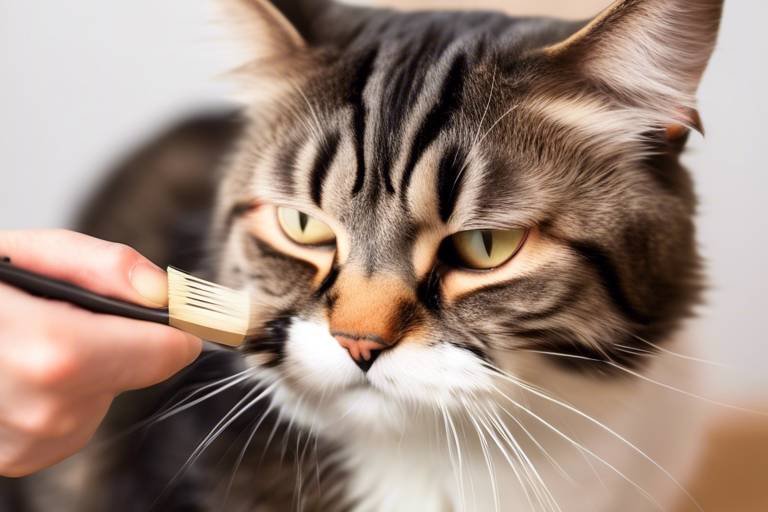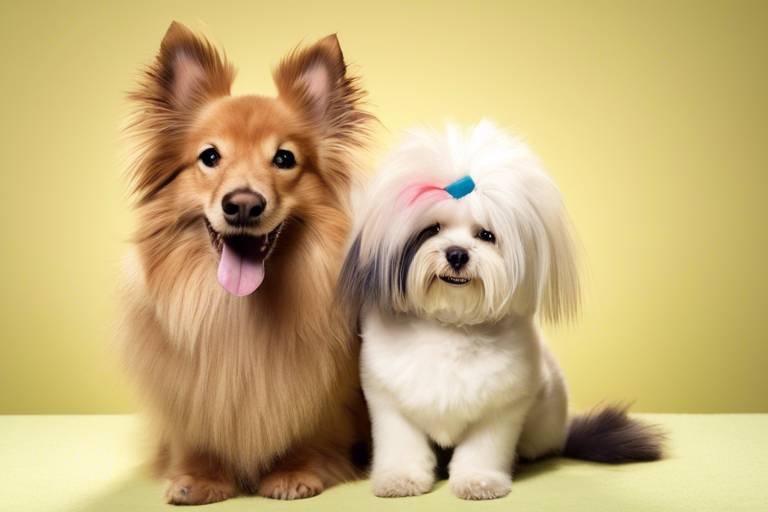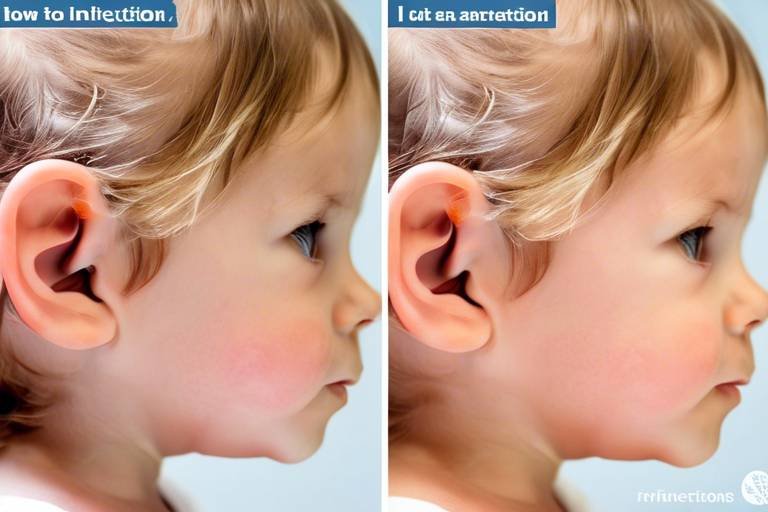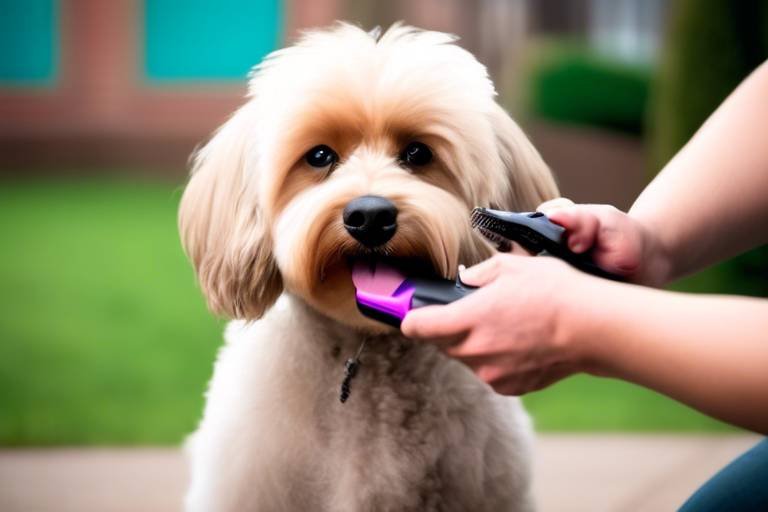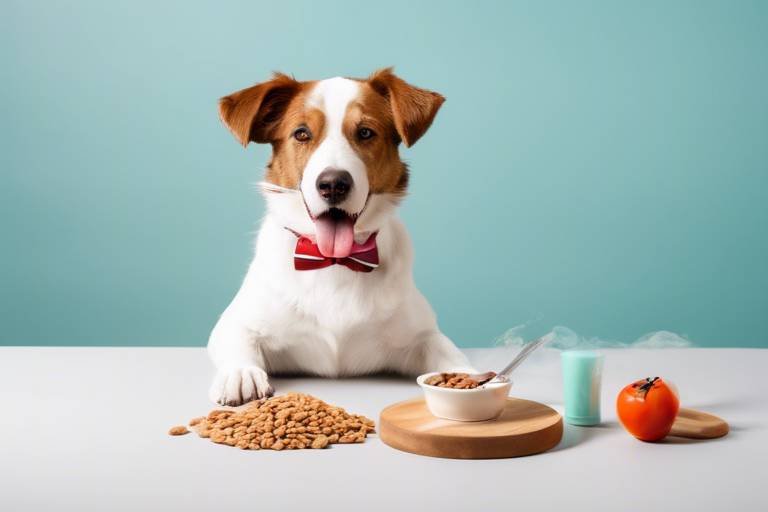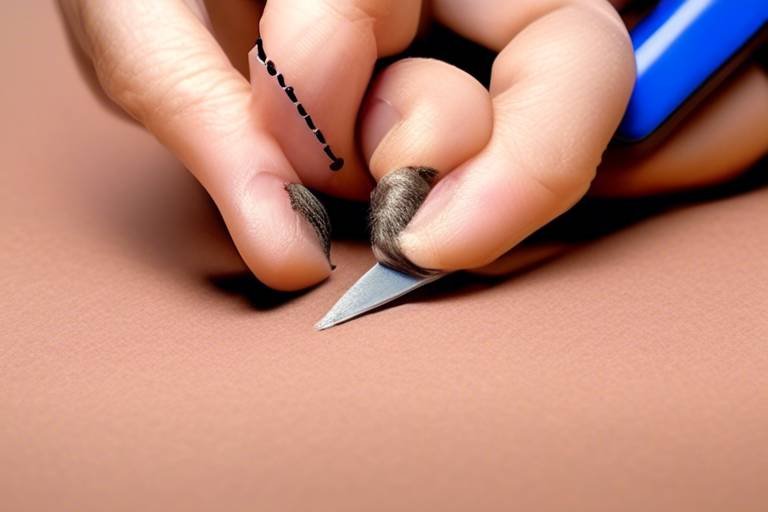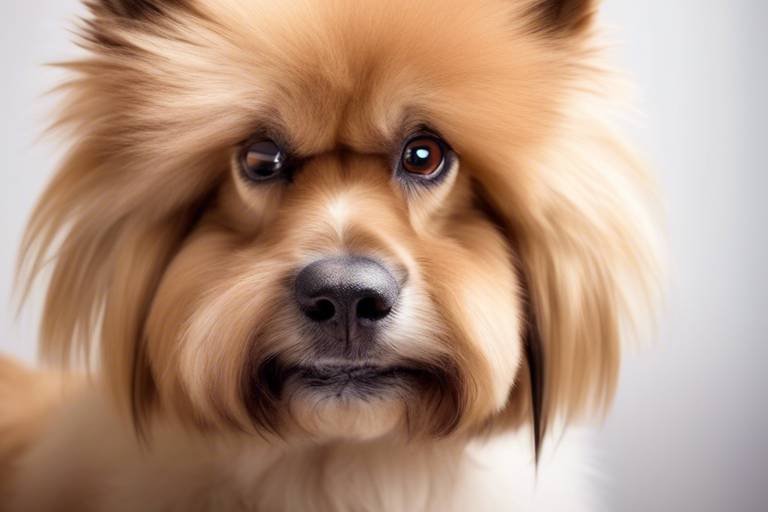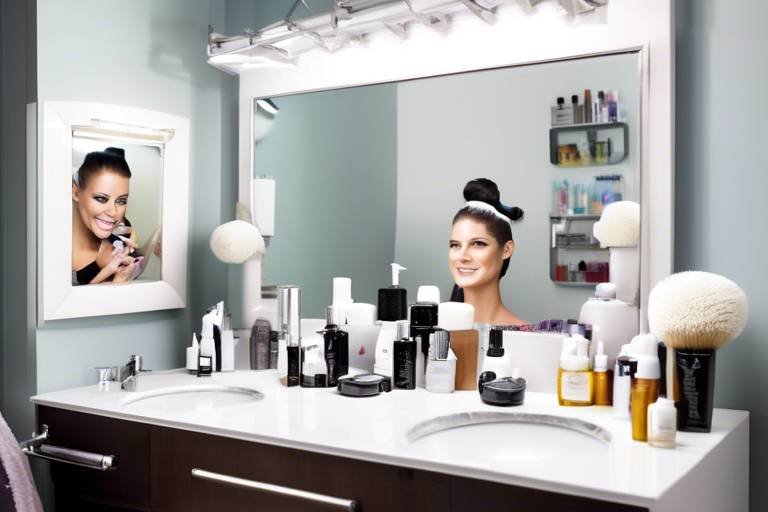The Benefits of Regular Grooming for Dogs with Long Fur
When it comes to our furry companions, especially those with long, luxurious coats, regular grooming is not just a chore—it's a necessity! Imagine your dog strutting around with a coat that shines like the sun, free from tangles and mats, and feeling comfortable in their own skin. Regular grooming can transform your dog's appearance and health, making it a vital part of their care routine. In this article, we will delve deep into the myriad of benefits that come with grooming long-haired dogs, from promoting their health to enhancing the bond between you and your pet. So, grab your grooming tools, and let’s embark on this journey to discover why grooming is essential for your furry friend!
Regular grooming helps maintain your dog's skin and coat health by preventing matting, reducing shedding, and identifying skin issues early. Think of grooming as a spa day for your dog! It’s not just about looking good; it’s about feeling good too. By brushing your dog's fur, you stimulate the skin, which promotes blood circulation and distributes natural oils throughout their coat. This is particularly important for long-haired breeds, as their beautiful coats can hide dirt and debris that can lead to skin infections if left unchecked. A well-groomed dog is a healthy dog, and grooming can help you catch potential health issues before they become serious problems. For instance, you might notice a rash or a lump that requires a vet’s attention during a grooming session.
Let’s face it—who doesn’t love a dog that looks fabulous? Grooming enhances your dog's coat by keeping it clean and free of tangles. A well-groomed dog not only looks better but also feels more comfortable. Imagine wearing a sweater that’s full of knots and tangles; it would be uncomfortable, right? The same goes for your dog. Regular grooming keeps their coat in tip-top shape, making it easier for them to move around freely. To achieve a beautiful coat, it’s essential to establish a grooming routine that suits your dog's specific needs. For example, some dogs may require daily brushing, while others may only need a weekly touch-up.
Mats can lead to skin irritation and discomfort for your furry friend. Regular brushing is crucial to prevent these issues and ensure your dog remains comfortable. Think of mats as tiny traps that can pull on your dog’s skin, causing pain and irritation. By incorporating grooming into your routine, you can effectively prevent mats from forming. Techniques like using a slicker brush or a dematting comb can help you tackle those stubborn tangles. Remember, a little effort goes a long way in keeping your dog happy and healthy!
Using the appropriate grooming tools is crucial for effective grooming. The right tools can make all the difference in your grooming experience. Here’s a quick guide to some essential grooming tools for long-haired dogs:
| Tool | Purpose |
|---|---|
| Slicker Brush | Removes loose fur and detangles |
| Dematting Comb | Helps to safely remove mats |
| Pin Brush | Distributes natural oils and smooths the coat |
| Undercoat Rake | Removes dead undercoat fur |
Understanding the frequency of grooming is essential. Depending on your dog's coat type and lifestyle, the grooming routine can vary significantly. Daily grooming is often recommended for dogs with very long or thick coats to prevent tangles and mats. On the other hand, dogs with less dense fur might only require a weekly grooming session. It’s important to observe your dog’s coat and adjust your grooming routine accordingly. Remember, consistency is key!
Regular grooming promotes healthy skin by removing dirt and debris. Just like we wash our hair to keep it clean and fresh, grooming helps to keep your dog’s skin healthy and free from irritants. Additionally, grooming helps to reduce the risk of skin infections, which can be a serious concern for long-haired breeds. By keeping their coat clean, you are also minimizing the likelihood of allergies and skin irritations that can arise from dirt buildup.
Grooming is an excellent opportunity for bonding between you and your dog. It’s not just about maintaining their appearance; it’s about building trust and connection. As you groom your dog, you are providing them with love and attention, reinforcing your bond. This shared experience can lead to a more trusting relationship, making your dog feel secure and loved. Plus, what could be more enjoyable than spending quality time with your furry best friend?
Establishing a calming grooming routine can reduce anxiety for both you and your dog. A stress-free grooming experience can make all the difference. Consider creating a dedicated grooming space in your home, complete with their favorite toys and treats. This can help your dog associate grooming with positive experiences. Play some soft music, and be patient—your dog will appreciate the effort you put into making grooming a relaxed and enjoyable experience.
Using positive reinforcement during grooming can enhance your dog's experience. Rewarding your dog with treats or praise during and after grooming can make the process much more enjoyable for them. This encourages good behavior and helps your dog to look forward to grooming sessions. Remember, a little bit of love and encouragement goes a long way in making grooming a pleasant activity for both of you!
- How often should I groom my long-haired dog? - It depends on the coat type, but daily to weekly grooming is typically recommended.
- What tools do I need for grooming? - Essential tools include a slicker brush, dematting comb, pin brush, and undercoat rake.
- Can grooming help with shedding? - Yes, regular grooming can significantly reduce shedding by removing loose fur.
- How can I make grooming less stressful for my dog? - Create a calm environment, use positive reinforcement, and be patient throughout the process.
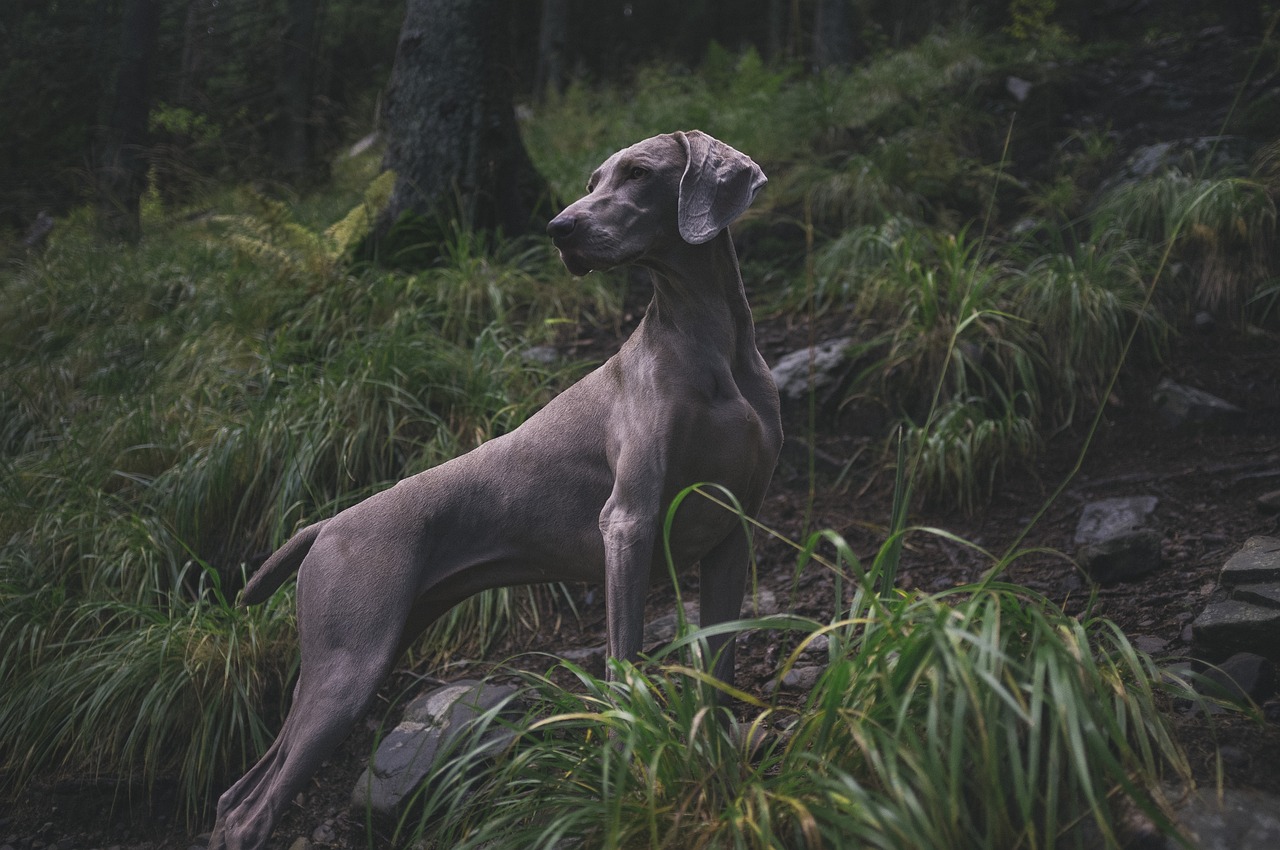
Health Benefits of Grooming
When it comes to our beloved long-haired dogs, grooming is more than just a cosmetic concern; it's a vital part of their overall health and well-being. Regular grooming sessions can significantly enhance your dog's quality of life by addressing various health issues that may arise from neglect. Just think of grooming as a health check-up that you can perform in the comfort of your home. By incorporating grooming into your routine, you're not only keeping your dog looking fabulous but also ensuring they feel their best.
One of the most pressing health benefits of grooming is the prevention of matting. Long fur can easily become tangled, leading to mats that can pull on the skin, causing pain and irritation. These mats can trap moisture and dirt, creating an ideal environment for skin infections. Regular brushing helps to keep the coat free from tangles, allowing air to circulate and keeping the skin healthy. In fact, a well-groomed coat acts as a barrier against environmental irritants, ensuring that your dog stays comfortable and happy.
Moreover, grooming allows pet owners to keep a close eye on their dog's skin and coat condition. During grooming sessions, you can easily spot any unusual lumps, bumps, or irritations that might indicate a health issue. Early detection is crucial in managing potential problems, as many skin conditions can be treated more effectively when caught early. So, think of grooming as your opportunity to conduct a mini health assessment of your furry friend!
Another significant advantage of regular grooming is the reduction of shedding. Long-haired breeds often shed more than their short-haired counterparts, and grooming helps to control this. By regularly brushing your dog, you can remove loose fur before it ends up all over your house. This not only keeps your home cleaner but also reduces the amount of allergens in the air, creating a healthier living environment for both you and your pet. In fact, a well-maintained coat can lead to less dander and fewer allergy triggers.
Additionally, grooming promotes better blood circulation and stimulates the skin, which can lead to healthier skin and a shinier coat. The act of brushing can be likened to a gentle massage, which not only feels great for your dog but also encourages the production of natural oils in their skin. These oils are essential for maintaining a healthy coat and skin barrier. So, the next time you're brushing your dog, remember that you're also giving them a mini spa treatment!
In summary, regular grooming is crucial for maintaining your long-haired dog's health. It prevents matting, helps in early detection of skin issues, reduces shedding, and promotes overall skin and coat health. By making grooming a routine part of your dog's care, you're investing in their happiness and well-being. So grab those brushes and combs, and let's keep those tails wagging!

Improved Coat Appearance
When it comes to our furry friends, their coat is often the first thing that catches our eye. A well-groomed dog not only looks stunning but also radiates health and vitality. Regular grooming plays a vital role in achieving that beautiful coat that turns heads at the dog park. Imagine your dog strutting around with a shiny, tangle-free coat, exuding confidence and charm. Doesn't that sound appealing?
One of the primary benefits of grooming is that it helps to keep your dog's coat clean and free of tangles. Over time, dirt, debris, and loose hair can accumulate in your dog's fur, leading to a dull appearance. Regular grooming sessions can significantly improve the cleanliness of your dog's coat, making it look fresh and vibrant. Plus, who doesn't love the feeling of running their fingers through a soft, clean coat?
But let's talk about tangles and mats for a moment. These pesky little nuisances can not only ruin your dog's appearance but can also cause discomfort. Mats can pull on the skin and lead to irritation, which is the last thing you want for your beloved pet. By incorporating regular grooming into your routine, you can effectively prevent these issues. In fact, a simple brushing session can do wonders in keeping your dog's coat looking its best. Here are some key points to consider:
- Regular Brushing: Brushing your dog's coat regularly helps to remove loose hair and prevents tangling.
- Bathing: A good bath every so often can also enhance your dog's coat appearance, making it look shiny and healthy.
- Professional Grooming: Sometimes, a trip to a professional groomer can provide that extra touch, especially for breeds with particularly long or thick fur.
In addition to aesthetics, a well-groomed coat can contribute to your dog's overall comfort. When your dog feels good in their own skin, it shows! A clean, well-maintained coat allows for better air circulation, which can be particularly important during warmer months. Think of it like wearing a comfy outfit versus a scratchy one; your dog deserves to feel their best!
Now, let's not forget about the emotional aspect of grooming. When you take the time to groom your dog, you are not only enhancing their appearance but also creating a special bond. The grooming process can be a wonderful way to spend quality time together, strengthening your relationship while ensuring your dog looks fabulous.
To summarize, regular grooming is essential for maintaining an . It enhances your dog's look, boosts their comfort, and fosters a deeper connection between you and your furry friend. So, grab those brushes and make grooming a fun part of your routine!
Q: How often should I groom my long-haired dog?
A: Generally, long-haired dogs should be groomed at least once a week, but daily grooming is ideal to prevent mats and tangles.
Q: What tools do I need for grooming?
A: Essential tools include a slicker brush, comb, and possibly a dematting tool. Choosing the right tools can make a significant difference in the grooming process.
Q: Can I groom my dog at home?
A: Absolutely! With the right tools and techniques, you can effectively groom your dog at home. Just be patient and make it a positive experience for your pet.
Preventing Mats and Tangles
When it comes to long-haired dogs, one of the most common issues pet owners face is the dreaded matting and tangling of their furry friend's coat. Imagine your dog's fur as a beautiful, flowing waterfall; it should cascade freely without any blockages. However, just like a waterfall can become clogged with debris, your dog's fur can become matted if not properly cared for. Regular grooming is essential to prevent these uncomfortable and often painful knots.
Mats are not just a cosmetic issue; they can lead to serious skin problems. When fur becomes matted, it can trap moisture and dirt against the skin, creating a breeding ground for bacteria and fungi. This can result in infections, irritations, and even hot spots, which are sore, inflamed areas on your dog's skin. By incorporating a regular grooming routine, you can keep your dog's coat healthy and free from these potential hazards.
To effectively prevent mats and tangles, consider the following techniques:
- Regular Brushing: Aim to brush your dog's coat at least a few times a week, if not daily. Use a slicker brush or a comb designed for long-haired breeds to gently work through any tangles before they turn into mats.
- Sectioning the Coat: Divide your dog's fur into manageable sections while grooming. This method allows you to focus on one area at a time, ensuring that you don't miss any tangles lurking beneath the surface.
- Be Gentle: When you encounter a mat, resist the urge to yank it out. Instead, use your fingers to gently separate the fur or use a dematting tool to carefully work through the knot.
Additionally, consider the environment in which you groom your dog. A calm, comfortable space can make a world of difference. If your dog associates grooming with a stressful experience, they may be more resistant to the process. Try to create a positive atmosphere with soothing music or treats to reward your dog for their cooperation.
Ultimately, the goal is to maintain a beautiful, healthy coat that your dog can be proud of. By preventing mats and tangles through regular grooming, you not only enhance your dog's appearance but also contribute to their overall well-being. So, grab those brushes and start a grooming routine that will keep your furry friend looking and feeling their best!
Here are some common questions regarding grooming long-haired dogs and preventing mats and tangles:
- How often should I groom my long-haired dog? Ideally, you should groom your long-haired dog at least 2-3 times a week, or even daily, depending on their coat type.
- What tools do I need for grooming? Essential tools include a slicker brush, a wide-toothed comb, and a dematting tool. Each serves a specific purpose in keeping your dog's coat healthy.
- Can I use human brushes on my dog? It's best to use brushes specifically designed for dogs, as human brushes may not effectively detangle or may cause discomfort.
Choosing the Right Tools
When it comes to grooming your long-haired dog, selecting the right tools is absolutely essential for achieving the best results. Just like a painter needs the right brushes to create a masterpiece, you need the proper grooming tools to keep your furry friend looking and feeling their best. With so many options available, it can be overwhelming to decide which tools to invest in. But don’t worry! I’m here to guide you through the process.
First and foremost, you’ll want to consider the type of coat your dog has. Different breeds have different grooming needs, and the right tool can make all the difference. For example, a dog with a silky, straight coat might benefit from a different brush than a dog with a thick, curly coat. Here’s a quick overview of some essential tools you might consider:
| Tool | Best For | Features |
|---|---|---|
| Pin Brush | Long, straight coats | Helps remove tangles and debris without pulling on the skin. |
| Slicker Brush | Curly or wavy coats | Effective at removing mats and tangles; has fine, short wires close together. |
| De-shedding Tool | Heavy shedders | Removes loose fur from the undercoat, reducing shedding significantly. |
| Comb | Finishing touch | Great for removing small tangles and ensuring a smooth finish. |
Additionally, consider the size and comfort of the tools. A brush that feels good in your hand will make the grooming process more enjoyable for both you and your dog. Look for ergonomic handles that provide a good grip. You’ll be spending quite a bit of time grooming, so comfort is key!
Don’t forget about grooming accessories! Tools like clippers for trimming and scissors for shaping can also be helpful, especially if your dog has a specific style. Always ensure that the clippers are designed for pet use, as human clippers can be too harsh and may cause discomfort.
Lastly, remember that regular maintenance of your grooming tools is crucial. Cleaning your brushes and combs after each use will not only keep them in top shape but will also help prevent the spread of dirt and bacteria. A little bit of care goes a long way in ensuring that your grooming sessions are effective and enjoyable!
In conclusion, choosing the right grooming tools is an investment in your dog’s health and happiness. By selecting the appropriate brushes, combs, and accessories, you can make grooming a positive experience that strengthens your bond with your furry friend.
Daily vs. Weekly Grooming
When it comes to grooming long-haired dogs, understanding the frequency of grooming sessions can make a world of difference in maintaining your pet's coat and overall health. You might find yourself wondering, "Should I groom my dog every day or is once a week enough?" The answer largely depends on your dog's specific coat type, lifestyle, and individual needs. For instance, dogs with particularly thick or curly fur may require daily grooming to prevent mats and tangles, while those with finer coats may only need a thorough brushing once a week.
Daily grooming can be a fantastic way to bond with your furry friend. It allows you to check for any skin issues, parasites, or irritations that might be hiding beneath the surface. Plus, it keeps their coat looking sleek and shiny, which is a win-win for both you and your pup! However, daily grooming is not just about aesthetics; it also plays a crucial role in your dog's hygiene. Regular brushing helps to distribute natural oils throughout the coat, keeping it healthy and nourished.
On the other hand, weekly grooming can be sufficient for dogs with less dense fur or those who lead a more relaxed lifestyle. If your dog enjoys playing outside but doesn't get excessively dirty, a weekly brushing session might be all they need to keep their coat in good condition. It’s essential to tailor your grooming routine to your dog’s specific needs. For example, if you notice a lot of loose fur or debris accumulating in between grooming sessions, it might be time to increase the frequency.
Here’s a quick comparison to help you decide:
| Grooming Frequency | Ideal For | Benefits |
|---|---|---|
| Daily Grooming | Thick or curly coats | Prevents mats, promotes skin health, enhances bonding |
| Weekly Grooming | Finer coats or less active dogs | Maintains coat appearance, reduces shedding |
Ultimately, the key is to observe your dog's coat and adjust your grooming routine as needed. Regular grooming not only enhances your dog's appearance but also fosters a deeper connection between you two. So, whether you choose to groom daily or weekly, make it a positive experience filled with love and care. You'll both look forward to this special time together!
- How often should I groom my long-haired dog? The frequency depends on your dog's coat type and lifestyle. Daily grooming is ideal for thick, curly fur, while weekly grooming may suffice for finer coats.
- What tools do I need for grooming? Essential tools include a slicker brush, a comb, and sometimes a de-shedding tool. Choose based on your dog's specific coat needs.
- Can grooming be a bonding experience? Absolutely! Grooming is a great way to spend quality time with your dog, strengthening your bond through gentle touch and attention.
Skin Health and Hygiene
When it comes to the overall well-being of your long-haired dog, are paramount. Regular grooming is not just about aesthetics; it plays a crucial role in maintaining your dog’s skin condition. Think of grooming as a health check-up that you can perform at home. By brushing your dog’s coat, you’re not only removing dirt and debris but also stimulating the skin and promoting a healthy coat. This simple act can help prevent common skin issues that many long-haired breeds face, such as infections, irritations, and allergies.
One of the most significant benefits of grooming is the removal of dead hair and skin cells. These can accumulate and create a breeding ground for bacteria and parasites. Regular brushing helps to keep your dog’s skin clean and reduces the risk of these unwanted guests. Additionally, grooming can help you spot any abnormalities on your dog’s skin, such as redness, lumps, or unusual growths, which may require veterinary attention. Early detection is key, and your grooming sessions can serve as a valuable opportunity to monitor your dog's skin health.
Moreover, grooming helps to distribute natural oils throughout your dog's coat, which keeps it shiny and moisturized. This not only enhances the appearance of your dog's fur but also contributes to a healthier skin barrier. To illustrate this, consider how your own skin feels after a good scrub versus when it’s neglected. Just like us, dogs thrive on cleanliness and care. A well-groomed dog is less likely to suffer from dry skin or other related issues, making grooming a win-win for both you and your furry friend.
Here are some essential grooming practices to keep in mind for maintaining skin health:
- Regular Brushing: Aim for at least two to three times a week, or daily if your dog has particularly long or thick fur.
- Bathing: Bathe your dog as needed, typically every 4 to 6 weeks, using a gentle dog shampoo that won’t strip natural oils.
- Checking for Parasites: During grooming, look for fleas, ticks, or other pests that can irritate the skin.
- Moisturizing: If your dog has dry skin, consider using a vet-recommended moisturizer to keep their skin hydrated.
In summary, grooming is much more than a chore; it’s an integral part of your dog’s overall health and hygiene. By making it a regular practice, you not only enhance your dog's appearance but also ensure their skin remains healthy and free from issues. Remember, a happy dog is a well-groomed dog!
Q1: How often should I groom my long-haired dog?
A: It’s recommended to groom long-haired dogs at least two to three times a week, or daily if their coat is particularly thick or prone to matting.
Q2: Can I use human shampoo on my dog?
A: No, human shampoos can be too harsh for dogs. Always use a shampoo specifically formulated for canine skin.
Q3: What should I do if I find a lump during grooming?
A: If you discover a lump or any abnormality, it’s best to consult your veterinarian for a professional evaluation.
Q4: How can I make grooming more enjoyable for my dog?
A: Use positive reinforcement, such as treats and praise, to create a positive association with grooming sessions.

Bonding Through Grooming
Grooming your dog is more than just a chore; it's a fantastic opportunity to strengthen the bond between you and your furry friend. Just think about it: when you spend time brushing, bathing, or trimming your dog's coat, you're not only taking care of their physical appearance but also nurturing your emotional connection. It's like a shared ritual that deepens your relationship, turning mundane grooming sessions into cherished moments.
When you engage in grooming, you're providing your dog with a sense of security and comfort. Imagine how your dog feels when you gently brush their fur, removing tangles and dirt. It's a soothing experience that can evoke feelings of trust and affection. This shared time can be incredibly rewarding, allowing you both to relax and enjoy each other's company. Moreover, it’s an opportunity for you to observe your dog closely, which can help you notice any changes in their skin or coat that might require attention.
Creating a calm and enjoyable grooming environment is essential for fostering this bond. Start by setting up a designated grooming space that feels safe and comfortable for your dog. You can use soft mats or blankets to make the area inviting. Additionally, consider playing soft music or using calming scents to create a soothing atmosphere. When your dog feels at ease, they are more likely to enjoy the grooming process, and this enhances your interaction.
Incorporating positive reinforcement techniques during grooming sessions can further enhance your dog's experience. For instance, rewarding your dog with treats or praise when they remain calm or allow you to brush certain areas can create a positive association with grooming. This not only makes the process enjoyable for your pet but also encourages them to look forward to future grooming sessions. Remember, it’s all about making grooming a fun and rewarding experience for both of you!
To summarize, grooming is not just about maintaining your dog's appearance; it’s a vital part of building a loving and trusting relationship. By turning grooming into a bonding experience, you can enhance your dog's well-being while deepening the emotional connection you share. So, the next time you pick up that brush or comb, remember that you’re not just grooming your dog; you’re also nurturing a beautiful friendship that will last a lifetime.
- How often should I groom my long-haired dog? - It varies by breed, but generally, daily brushing is recommended to prevent mats and tangles.
- What tools do I need for grooming? - Essential tools include a slicker brush, comb, and possibly clippers for specific areas.
- Can grooming help with my dog's anxiety? - Yes! A calm grooming routine can help reduce anxiety for both you and your dog.
- Is it necessary to bathe my dog regularly? - Bathing frequency depends on the dog's activity level and coat type, but over-bathing can strip natural oils.
Creating a Calm Environment
Creating a calm environment during grooming is essential for both you and your dog. Just imagine how stressful it can be to sit in a chaotic room while someone tries to comb your hair. Your furry friend feels the same way! By establishing a soothing atmosphere, you can significantly reduce anxiety, making the grooming experience enjoyable and effective.
Start by choosing a quiet space in your home where your dog feels safe. This could be a cozy corner of the living room or a designated grooming area. Ensure the area is free from loud noises and distractions. Play soft music or use white noise to drown out any sudden sounds that might startle your pup. Dogs are sensitive to their surroundings, and a peaceful setting can help them relax.
Additionally, consider the time of day you choose for grooming. Some dogs are more energetic in the morning, while others might be calmer in the evening. Observe your dog's behavior and schedule grooming sessions when they are most likely to be relaxed. This will not only make the process smoother but also foster a sense of trust between you and your pet.
Another helpful tip is to incorporate familiar scents. Dogs are highly influenced by their sense of smell, so using calming essential oils like lavender can create a serene environment. Just be sure to dilute the oils properly and consult your veterinarian to ensure they are safe for your pet. You can also use a favorite blanket or toy to provide comfort during grooming.
Lastly, remember to take your time. Rushing through the grooming process can create tension. Instead, approach each grooming session with patience and positive energy. Use soft, gentle strokes and speak to your dog in a soothing voice. This not only calms them but also strengthens your bond. After all, grooming is not just about maintaining their coat; it's about creating a shared experience that both you and your dog will look forward to.
- How often should I groom my long-haired dog? The frequency of grooming depends on the dog's coat type. Generally, daily brushing is recommended for long-haired breeds to prevent mats and tangles.
- What tools do I need for grooming? Essential tools include a slicker brush, comb, and possibly a dematting tool for tougher mats. Choosing the right tools makes a significant difference.
- Can grooming be a bonding experience? Absolutely! Grooming provides a wonderful opportunity for you to spend quality time with your dog, enhancing your emotional connection.
- What if my dog is anxious during grooming? Creating a calm environment, using positive reinforcement, and taking breaks can help ease your dog's anxiety during grooming sessions.
Positive Reinforcement Techniques
When it comes to grooming your long-haired dog, can transform what might be a stressful task into a delightful bonding experience. Just like humans, dogs thrive on praise and rewards, and using these techniques can help your furry friend associate grooming with positive feelings. Imagine your dog’s tail wagging with excitement as you brush their coat, knowing that a tasty treat or a gentle pat is just around the corner!
One effective way to implement positive reinforcement is to reward your dog immediately after they display calm behavior during grooming. For instance, if your dog sits still while you brush their fur, offer them a small treat or a favorite toy. This immediate reward helps them make the connection between good behavior and positive outcomes. You might even find that your dog starts to look forward to grooming sessions, eagerly jumping onto the grooming table or mat!
Additionally, verbal praise plays a crucial role in reinforcing good behavior. Use a cheerful tone to say things like, “Good boy!” or “You’re doing great!” as you groom. Your dog will pick up on your enthusiasm, and it can create a positive feedback loop that encourages them to stay calm and relaxed. Remember, consistency is key! The more regularly you reward good behavior, the more ingrained it becomes.
Another technique to consider is the use of grooming breaks. If your dog seems restless or anxious, take a short break and allow them to play with a toy or have a quick cuddle session. This not only breaks the monotony of grooming but also reinforces the idea that grooming is a part of a fun and loving routine. You can explain to your dog that it’s okay to take a breather, and when they return to grooming, they’ll be more relaxed and receptive.
To further enhance the experience, you can create a grooming schedule that includes a variety of activities to keep your dog engaged. For example, you might alternate between brushing, bathing, and playing with toys. This variety helps to reduce boredom and keeps your dog excited about grooming. You could even consider incorporating some light training during grooming sessions, such as teaching them to give their paw or roll over, which can make the experience even more enjoyable.
In summary, by using positive reinforcement techniques during grooming, you not only improve your dog's behavior but also strengthen the bond between you. It’s all about making grooming a fun and rewarding experience rather than a chore. So grab those treats, prepare your brushes, and get ready to enjoy some quality time with your long-haired canine companion!
- How often should I groom my long-haired dog?
It depends on the breed and coat type, but generally, long-haired dogs should be groomed at least once a week. Daily grooming is ideal for preventing mats and tangles. - What tools do I need for grooming?
Essential tools include a slicker brush, comb, and scissors for trimming. Always choose tools that are suitable for your dog's coat type. - Can I groom my dog at home?
Absolutely! With the right tools and techniques, you can groom your dog at home. Just ensure you take your time and create a calm environment. - What if my dog doesn't like grooming?
Start slow and use positive reinforcement techniques. Gradually introduce grooming sessions and make them as enjoyable as possible.
Frequently Asked Questions
- How often should I groom my long-haired dog?
The frequency of grooming depends on your dog's coat type and lifestyle. Generally, long-haired dogs should be groomed at least once a week, but daily grooming is ideal for those prone to matting. Think of it like brushing your teeth; the more regularly you do it, the healthier it is!
- What tools do I need for grooming my long-haired dog?
Having the right tools is essential for effective grooming. You'll want to invest in a good quality brush, a comb, and possibly some detangling spray. It's like having the right ingredients when cooking; without them, the final dish just won't turn out right!
- Can grooming help with my dog's shedding?
Absolutely! Regular grooming helps reduce shedding by removing loose fur and dander. It's like cleaning out your closet; the more you get rid of the old stuff, the more space you have for the new! Plus, it keeps your home cleaner and fresher.
- What if my dog hates being groomed?
If your dog is anxious about grooming, try creating a calm environment. Use positive reinforcement techniques, like treats and praise, to make the experience more enjoyable. Think of it as a spa day; you want them to associate grooming with relaxation and pampering!
- How can I tell if my dog has skin issues?
During grooming, keep an eye out for any unusual bumps, redness, or excessive itching. If you notice anything concerning, consult your vet. It's like being a detective; you need to pay attention to the clues your dog’s skin is giving you!
- What are the benefits of grooming beyond appearance?
Grooming isn't just about looking good; it's also about health and bonding. Regular grooming helps maintain skin health and can strengthen the emotional connection between you and your dog. It's like a form of communication that deepens your relationship!





